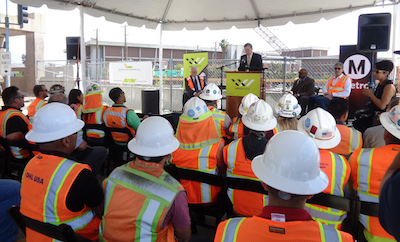U.S. Labor Dept. data show that more than 100,000 lost-time hand injuries occur every year and that these injuries cost an average of between $6,000-$7,000 in workers’ compensation claims.
That's one big reason why when the Los Angeles County Metropolitan Transportation Authority (Metro) teamed up to promote job safety with a few of its major contractors on April 27 at historic Union Station in Los Angeles, it emphasized hand safety for the thousands of construction workers on Metro transit projects across the city.
Recognizing National Safety Week, which runs May 1 - 5, the event was hosted by Metro CEO Phillip Washington; Darryl Waters, vice president of The Walsh Group; Mike Aparicio, executive vice president, Skanska/Traylor/Shea; and John Fasana, metro board chair.
|

|
| Construction workers gather at the pre-Safety Week event at Union Station April 27 in Los Angeles. Photo by Greg Aragon for ENR |
"The theme for the week is 'It's in Your Hands' and this puts focus on hand safety, which is the second most common cause of missed work days for the construction industry," said Fasana.
Washington said safety is so important at Metro that its contractors are selected in part "because of their ability to manage an assertive safety program, not only with their employees, but with their subcontractors as well." He said Metro contractors have been successful in keeping industry injuries well below the heavy civil construction averages.
"Our contractors have worked nearly seven million hours through February 2017 and they have an injury rate of 1.8 per 200,000 hours worked; that is 35 percent below the industry average of 2.8%," said Washington.
According to industry statistics, hand injuries represent one-third of all reported workplace incidents, and approximately 75% of industrial injuries that cause partial disability involve the hands. With this in mind, Safety Week is focusing on the hands.
A study on the U.S. Occupational Safety and Health Administration#39;s website found that 70% of hand and arm injuries could have been prevented by proper use of gloves. To help reduce hand injuries, OSHA's Hand Protection Standard states that employers require all employees to use appropriate hand protection when exposed to hazards such as those from skin absorption of harmful substances; severe cuts or lacerations; severe abrasions; punctures; chemical burns; thermal burns; and harmful temperature extremes.
"Whether you are a first-year apprentice or a CEO, safety is for all of us; we are all in across the board on this together," said Waters, whose company is building the roughly $2 billion, 8.5-mi-long Crenshaw LAX Transit Corridor Project. "What we are trying to achieve is zero safety incidents on any job ever and to that end we are investing a lot in training, both in the classroom and on the worksite."
The Safety Week discussion was held in front of Patsaouras Plaza Busway Station Project, which is currently under construction at Union Station. Fasana says the $40-million project has zero accidents or injuries resulting in loss of work time over four months of construction so far. "So this project is a perfect backdrop to promote Safety Week."
To further highlight the importance of hand safety, the speakers concluded their presentation by outlining their hands on a giant poster and putting their signatures alongside other construction workers in a show of solidarity.






Post a comment to this article
Report Abusive Comment